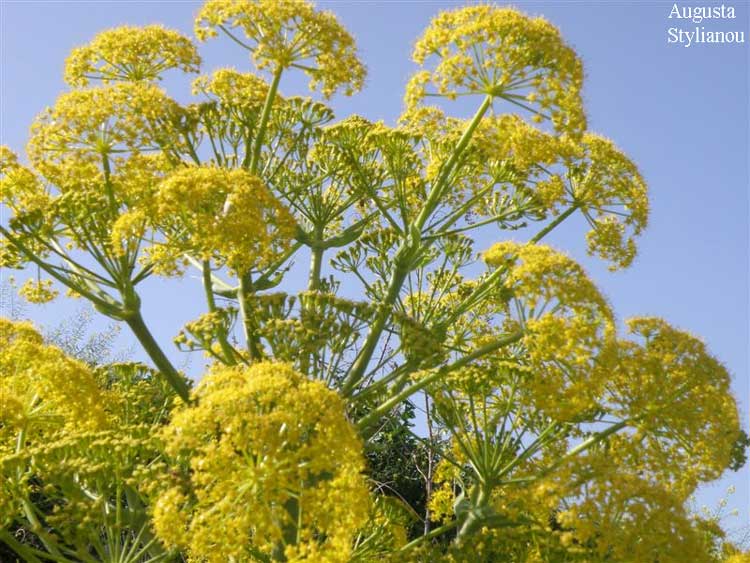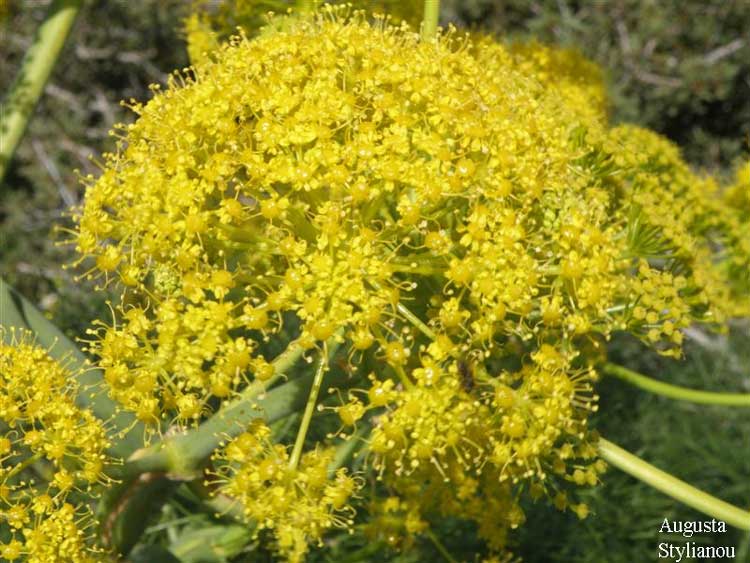
Ferula communis, Photo: Augusta Stylianou Artist
Classification System: APG IV
Superregnum: Eukaryota
Regnum: Plantae
Cladus: Angiosperms
Cladus: Eudicots
Cladus: Core eudicots
Cladus: Asterids
Cladus: Campanulids
Ordo: Apiales
Familia: Apiaceae
Subfamilia: Apioideae
Tribus: Scandiceae
Subtribus: Ferulinae
Genus: Ferula
Species: Ferula communis
Subspecies: F. c. subsp. brevifolia – F. c. subsp. cardonae – F. c. subsp. catalaunica – F. c. subsp. communis – F. c. subsp. linkii
Name
Ferula communis L., 1753

Ferula communis, Photo: Augusta Stylianou Artist
References
Linnaeus, C. 1753. Species Plantarum. Tomus I: 246. Reference page.
Links
Hassler, M. 2018. Ferula communis. World Plants: Synonymic Checklists of the Vascular Plants of the World In: Roskovh, Y., Abucay, L., Orrell, T., Nicolson, D., Bailly, N., Kirk, P., Bourgoin, T., DeWalt, R.E., Decock, W., De Wever, A., Nieukerken, E. van, Zarucchi, J. & Penev, L., eds. 2018. Species 2000 & ITIS Catalogue of Life. Published online. Accessed: 2018 Aug. 29. Reference page.
International Plant Names Index. 2018. Ferula communis. Published online. Accessed: Aug. 29 2018.
The Plant List 2013. Ferula communis in The Plant List Version 1.1. Published online. Accessed: 2018 Aug. 29.
Tropicos.org 2018. Ferula communis. Missouri Botanical Garden. Published online. Accessed: 29 Aug. 2018.
USDA, ARS, Germplasm Resources Information Network. Ferula communis in the Germplasm Resources Information Network (GRIN), U.S. Department of Agriculture Agricultural Research Service. Accessed: 08-Apr-12.
Vernacular names
Deutsch: Riesenfenchel, Gemeines Steckenkraut, Gemeines Rutenkraut
español: Cañaheja
suomi: Välimerenkeltaputki
français: Férule Commune
italiano: Finocchiaccio
Ferula communis, the giant fennel,[1] is a species of flowering plant in the carrot family Apiaceae. It is related to the common fennel (Foeniculum vulgare), which belongs to the same family.
Ferula communis is a tall herbaceous perennial plant. It is found in Mediterranean and East African woodlands and shrublands.[2][failed verification] It was known in antiquity as laser[3] or narthex.[4]
Human use
Its young stems and inflorescences were eaten in ancient Rome, and are still eaten in Morocco today. However, culinary uses of this species are not always safe and poisoning may occur.[5] In Sardinia two different chemotypes of Ferula communis have been identified: poisonous (especially to animals like sheep, goats, cattle, and horses) and non-poisonous.[6] They differ in both secondary metabolites patterning and enzymatic composition.[7]
The resin of the subspecies F. communis subsp. brevifolia is called “gum ammoniac of Morocco”.[8]
The phenolic compound ferulic acid is named for the giant fennel, from which it can be isolated.
In Ancient Greek mythology, Prometheus gave mortals fire by hiding it in the plant's hollow stalk. (cite Aeschylus' Prometheus Bound)
Resin extraction
Since antiquity, the resin of Ferula species has been used for medicinal purposes. The resin, in the form of a sticky latex, was usually extracted from the lower stalk or root, with the root resin being the finest-grade.[9]
Where the resin of giant fennel (Ferula communis) was farmed, a small hole was pierced in its root with a sharp instrument, after clearing away all rocks and earth that cling to the exposed root. A small trench was dug beneath the root and overlayed with several smooth and flat stones at the bottom for collecting the exuded resin.[9] The piercing was made deep enough into the root or lower stalk to ensure a steady flow of resin on its own pressure.
The resin was usually harvested in the dry and hot summer months, when dampness and moisture could not corrupt the resin. The resin hardens when exposed to the air, upon which it changes color to a brownish-red. The resin that exudes in coagulated, drop-like form is considered superior to that which runs down loosely.[9]
As a tool for punishment
In the past, rods and whips for disciplinary purposes were made from the stalk of Ferula. From this, we have latin ferire (to hit), and also the Swedish färla (disciplinary tool used in schools in the past).[10]
References
BSBI List 2007 (xls). Botanical Society of Britain and Ireland. Archived from the original (xls) on 2015-06-26. Retrieved 2014-10-17.
"Flora of Israel Online entry". Archived from the original on 2012-03-14. Retrieved 2011-02-23.
Grocok; Grainger (eds.). Apicius: A critical edition with an introduction and an English translation.[full citation needed]
Kandeler, R.; Ullrich, W.R. (2009). "Symbolism of plants: Examples from European-Mediterranean culture presented with biology and history of art: MARCH: Silphion and narthex". Journal of Experimental Botany. 60 (3): 715–717. doi:10.1093/jxb/erp041. PMID 19269995.
A Guide to Medicinal Plants in North Africa (PDF). IUCN. Centre de Cooperation pour la Méditerranée. Málaga: IUCN Centre for Mediterranean Cooperation. 2005. pp. 121–123. ISBN 2-8317-0893-1. OCLC 494618983.
Verotta, Luisella, ed. (1997). Virtual activity, real pharmacology: Different approaches to the search for bioactive natural compounds. Trivandrum, India: Research Signpost. ISBN 9788186481172.
Zucca, Paolo; Sanjust, Enrico; Loi, Martina; Sollai, Francesca; Ballero, Mauro; Pintus, Manuela; Rescigno, Antonio (June 2013). "Isolation and characterization of polyphenol oxidase from Sardinian poisonous and non-poisonous chemotypes of Ferula communis (L.)". Phytochemistry. 90: 16–24. doi:10.1016/j.phytochem.2013.02.019. PMID 23523329.
Stapf, Otto (1907). "The gums ammoniac of Morocco and the Cyrenaica. (Ferula communis, L., var. brevifolia, Mariz; Ferula marmarica, Aschers. and Taub.)". Bulletin of Miscellaneous Information. Kew, UK: Royal Botanic Gardens. 1907 (10): 375–388. doi:10.2307/4111767. ISSN 0366-4457. JSTOR 4111767.
Ḳrispil, Nissim (1985). A Bag of Plants (the useful plants of Israel) (in Hebrew). Vol. 3 (Ṭ.-M.). Jerusalem, IS: Cana Publishing House. p. 441. ISBN 965-264-011-5. OCLC 959573975. s.v. Ferula communis
"färla". Svenska Akademiens Ordbok (word definition & etymology) (in Swedish). 1926.
Retrieved from "http://en.wikipedia.org/"
All text is available under the terms of the GNU Free Documentation License

